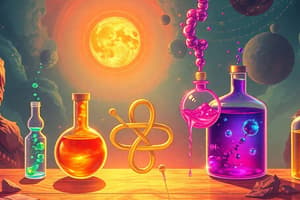Podcast
Questions and Answers
What does stoichiometry refer to in chemistry?
What does stoichiometry refer to in chemistry?
- Measuring reaction rates
- Identifying reaction products
- Determining states of matter
- Predicting amounts of substances in reactions (correct)
In the synthesis of water, how many molecules of oxygen react with four molecules of hydrogen?
In the synthesis of water, how many molecules of oxygen react with four molecules of hydrogen?
- 4
- 1
- 3
- 2 (correct)
What is the main outcome of a chemical reaction?
What is the main outcome of a chemical reaction?
- Balancing atomic masses
- Maintaining the same chemical properties
- Changing the physical state of matter
- Producing new substances (correct)
How does stoichiometry help chemists in experiments?
How does stoichiometry help chemists in experiments?
What does equilibrium in chemistry refer to?
What does equilibrium in chemistry refer to?
Why is it important for chemists to understand chemical equilibrium?
Why is it important for chemists to understand chemical equilibrium?
In a decomposition reaction, what happens?
In a decomposition reaction, what happens?
Which type of reaction involves two or more simple substances combining to form one more complex substance?
Which type of reaction involves two or more simple substances combining to form one more complex substance?
What is the main concept behind stoichiometry in chemical reactions?
What is the main concept behind stoichiometry in chemical reactions?
What characterizes an equilibrium state in a chemical reaction?
What characterizes an equilibrium state in a chemical reaction?
What happens to a system at equilibrium when there is an increase in the concentration of a reactant?
What happens to a system at equilibrium when there is an increase in the concentration of a reactant?
During which type of reaction does one element replace another within a compound?
During which type of reaction does one element replace another within a compound?
Study Notes
Exploring Chemistry through Stoichiometry, Reactions, and Equilibrium
Chemistry is an exciting field that revolves around understanding matter, its properties, interactions, and transformations. Three fundamental concepts — stoichiometry, chemical reactions, and equilibrium — help us delve deeper into this vast world of elements and compounds. Here we'll dive into these pillars of chemistry, exploring their significance with real examples.
I. Stoichiometry: Balancing Matter
Stoichiometry refers to the quantitative relationships between reactants and products during chemical reactions. It helps chemists predict amounts of each substance involved in reactions, calculate reaction yields, and determine limiting reagents in experiments. A common introductory example is the synthesis of water (H₂O) from hydrogen gas (H₂) and oxygen gas (O₂):
[ \text{2 H}_2 + \text{ O}_2 \rightarrow \text{ 2 H}_2\text{O} ]
In this balanced equation, the coefficients indicate molar ratios; therefore, two molecules of hydrogen must combine with one molecule of oxygen to produce two molecules of water. This principle applies to all other reactions, allowing chemists to accurately measure and control experimental conditions.
II. Chemical Reactions: Transforming Substances
A chemical reaction occurs when atoms rearrange themselves within or between molecules, forming new substances with different physical and chemical properties. These reactions can range from simple single displacement reactions like replacing an atom or ion in a compound to complex redox processes involving multiple steps and intermediates. Common types of reactions include:
- Combination reactions: Two or more simple substances combine to form one more complex substance. For instance, combining sodium and chlorine produces sodium chloride (NaCl).
- Decomposition reactions: One compound breaks down into simpler substances. An example being calcium carbonate (CaCO₃) decomposeing into calcium oxide (CaO), carbon dioxide (CO₂), and heat.
- Synthesis reactions: Simple substances join together to form a more complex substance. For example, ammonia (NH₃) production through the Haber process (N₂ + 3 H₂ → 2 NH₃).
- Single replacement (displacement) reactions: One element replaces another within a compound, yielding an element, an ion, or a composite of both. Copper (CU) corroding by replacing zinc (ZN) in Zn(NO₃)₂ solution results in Cu(NO₃)₂ and Zn dust formation.
Each type of reaction has characteristic patterns and balances governed by stoichiometry. By knowing how reactants interact with one another, scientists understand what products will be formed under specific reaction conditions.
III. Equilibrium: Striking a Balance
When reactants come into contact, they may continue to react until reaching an unchanging ratio known as dynamic equilibrium. At this point, the rate of forward reactions equals the rate of reverse reactions. To illustrate this concept, let's consider a reversible synthesis reaction producing nitrogen monoxide (NO):
[ \text{N}{2(g)} + \text{O}{2(g)} \rightleftharpoons \text{2 NO}{(g)} \qquad K{\text{p}} = [\text{NO}]^2 / (\text{P}_{\text{N}2}\cdot\text{P}{\text{O}_2})^\text{(1/2)}]
The double arrow symbolizes a reversible reaction, whereby nitrogen (N₂) and oxygen (O₂) gases can combine to create nitric oxide (NO) according to Le Chatelier's Principle, which states that if a system at equilibrium experiences changes such as pressure, temperature, or concentration, it will adjust itself so that the effect becomes minimal. In the case of our example, increasing the initial concentrations of either N₂ or O₂ would cause the equilibrium to shift towards the direction counteracting the change (i.e., decreasing the concentration of overly abundant species while simultaneously increasing the concentration of those present in lower quantities).
Developing a deep understanding of stoichiometry, chemical reactions, and equilibrium provides the foundation upon which countless scientific discoveries rest, making them essential tools for any chemist. With these skills, you can tackle challenges ranging from developing renewable energy sources to creating advanced materials for future technology.
Studying That Suits You
Use AI to generate personalized quizzes and flashcards to suit your learning preferences.
Description
Dive into the foundational principles of chemistry through stoichiometry, chemical reactions, and equilibrium. Learn how to balance equations, understand various types of reactions, and grasp the concept of dynamic equilibrium in chemical systems.




